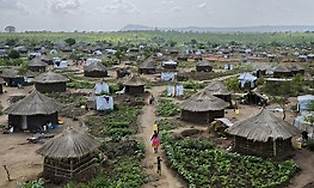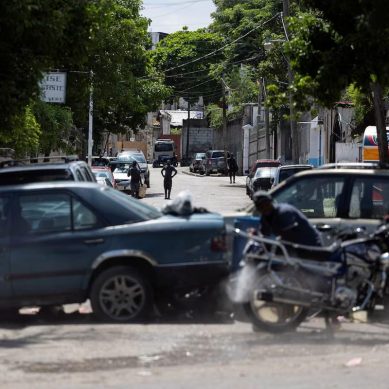
A World Food Programme (WFP) policy shift to prioritise aid for the neediest in the midst of global budget cuts has left many of the 1.4 million refugees it assists in Uganda considering desperate measures as they scramble to feed themselves and their families, it has been established.
Refugees say crime, child marriage, prostitution and sexual abuse are all on the rise, as families try to fill the gaps left by reductions in rations and cash assistance. Some parents have reported withdrawing children from school as they can’t afford the fees.
WFP hoped to target 25 per cent of Uganda’s most vulnerable refugees. Because of budget shortfalls, only 14 per cent were placed into the highest category of assistance. Roughly 4 per cent of the refugee population now receives no food or cash assistance.
A leaked report from a consortium of response organisations said cuts have triggered crime, prostitution, sexual abuse and child marriages. Aid officials said they raised concerns before the cuts were rolled out about security ramifications for their staff.
WFP says available funding will determine how many people can be recategorised if they appeal their cases.
Spurred by continuous funding shortfalls, the prioritisation scheme – billed as a “needs-based” policy to assist the most vulnerable and wean others off assistance – began in 2021, with the last and most controversial phase being rolled out since July.
Last year, overall ration cuts meant refugees were receiving less than 40 per cent of their basic survival rations. Now, as the scheme is fully rolled out, some are receiving even less or nothing at all, with several refugees and aid officials describing the impacts as disastrous.
Security measures in the refugee settlements have also been stepped up since July to prevent protests, with police overseeing food distributions, while aid groups had expressed fears for the safety of their staff because of potential unrest over the new measures.
“We thought we were in peace,” Peter John Ayume, a refugee leader in Imvepi settlement, which is located – like most of Uganda’s 13 refugee settlements – in the northwest of the country, said in November. “But now we are undergoing economic war.”
Uganda response insiders say the prioritisation scheme is a policy experiment going wrong – and one that could have global implications as WFP makes cuts in nearly half of the 86 countries where it operates, including Bangladesh, Haiti, and Syria.
Uganda, which allows refugees to work and move freely within the country, is often held up as an example of a progressive host nation that is a good testing ground for others to learn from: What works in Uganda – or doesn’t – often influences what happens in other responses.
During a six-month investigation, we reviewed leaked reports from WFP, the UN’s refugee agency (UNHCR), and other organisations involved in the response, and spoke to more than a dozen aid workers, diplomats, government officials, UN workers and refugees living in eight of the country’s settlements.
The investigation found that the rollout of the new prioritisation scheme had dire consequences for many refugees and that WFP pushed it through without thoroughly consulting other aid groups or those who depend on the assistance, according to sources interviewed.
In the new prioritisation policy, refugees are assigned different vulnerability levels – from Category 1 for the most vulnerable to Category 3 for those considered self-sufficient. The 4 per cent of refugees in Category 3 now get nothing. The 82 per cent deemed “moderately vulnerable” (Category 2) receive about 30 per cent of WFP’s standard rations, and the 14 per cent considered “highly vulnerable” receive 60 per cent.
Several people interviewed said there were problems with the data that was collected to justify these changes. Some critics said much of it was old, while others said there were flaws that risked placing vulnerable refugees into categories 2 and 3.
In response to questions, WFP said it worked closely with partners before the scheme was rolled out in stages, and that the prioritisation policy was aimed at using data to make sure the most vulnerable people receive the highest possible ration.
“These are painful choices for our staff to make, but even more important when resources are stretched,” a WFP spokesperson said in a December 13 email. The UN agency added, however, that due to budget shortfalls it was only able to provide the highest rations to 14 per cent of the refugee population, instead of the 25 per cent it had initially targeted.
The new prioritisation policy did not come out of nowhere. For a number of years, donors have been pushing to reorient refugee assistance in Uganda, according to interviews with donor representatives and humanitarian actors.
In particular, the United States and Britain – the largest donors to the response – have questioned blanket support in a protracted crisis like Uganda, where refugees are likely to stay for many more years, according to those interviewed.
Since the prioritisation, refugees in the so-called “highly vulnerable” category receive 7.6 kilos of cereal a month or, for those receiving cash, between $6.40 and $7.40 per month. Many of the refugees now receiving less assistance said they haven’t been able to appeal the changes, reporters found.
“I got no warning for people being categorised,” Isaac Ankora, who lives in Bidi Bidi, said in August, adding that he only discovered his family would stop receiving assistance when his wife collected their food rations in July, giving them little time to prepare.
“I discovered [my category] when I went for the food ration,” Enock Suro, who lives in Kyangwali settlement, said in September. “I had no prior idea about it.”
Out of nearly 22,000 appeal claims, WFP said roughly 1,200 have been recategorised, but added that the number of people who can be recategorised depends on available funding.
WFP – one of the humanitarian sector’s best-funded outfits – had already been implementing ration cuts due to budget shortfalls for several years, and the UN agency said various forms of prioritisation have been going on in its work around the globe for a long time.
“Prioritisation has long been at the core to all WFP operations in identifying, targeting and prioritising the most vulnerable households,” a WFP spokesperson said. “It is contextual and particularly important as humanitarian aid budgets are shrinking.”
But aid officials said it’s still vital to get the process right, especially as what happens in Uganda could be used to guide food aid responses in other settings as funding shrinks and needs grow.
“Prioritisation, as such, is a good policy,” one humanitarian worker said, requesting anonymity because they weren’t authorised to speak to reporters. “But if people get less food or cash, they need to get more support to be self-reliant. You need to drastically rethink your policy, and think of major ways to support refugee livelihoods. And this is not [being] done [in Uganda].” The aid worker also described the current levels of assistance as “absolute madness”.
“The categorisation process and the tool being used have some gaps […] some families may be overlooked. Child-headed households, for example, will never make it to Category 1. It’s not a case-by-case consideration, so some families may slip through the cracks.“
Before the changes in Uganda were implemented, UNHCR and other humanitarian organisations, including WFP itself, had raised concerns about their potential consequences.
One study, carried out on behalf of WFP, UNHCR and the Ugandan government, called the idea of vulnerability criteria “relatively arbitrary” and pointed out a very high exclusion error rate, meaning that refugees could be wrongly placed in a less vulnerable category.
In private minutes seen from a Refugee and Humanitarian Partners Group (RHPG) meeting on June 6, WFP also raised concerns about the prioritisation, given the reductions taking place in the broader cuts policy.
“We are uncertain if prioritisation will be successful because ration cuts are taking over,” one WFP official stated during the meeting.
Although Uganda provides land and a safe haven to refugees, it says its obligations end with hosting and it is up to the aid organisations to come up with the rest of the support.
“The government has no ability to provide additional support beyond what we are already providing,” Douglas Asiimwe, Uganda’s acting refugee commissioner, said. “The international community must meet their obligations and commitments towards refugees.”
Uganda hosts one of the largest refugee communities in the world, but the response is also one of the worst-funded. The overall inter-agency response in Uganda has a funding shortage of 87 per cent, or $846 million, according to the private minutes from the RHPG meeting in June.
And with budget cuts also affecting other organisations – UNHCR, which oversees the refugee response in coordination with the Ugandan government, has a funding gap of roughly 74 per cent or about $255 million – response workers said they fear a “slow-burn crisis” could push refugees out of Uganda, perhaps back to the conflict areas they fled. Most escaped wars in Sudan, South Sudan, and the Democratic Republic of the Congo.
- The New Humanitarian report











